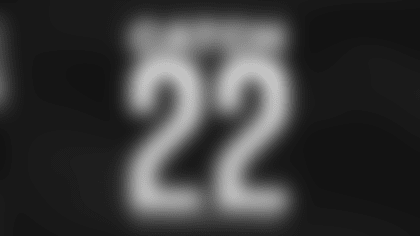It's time for my seventh annual Patriots top-50 big board, where we'll rank the best fits for New England in the 2025 NFL Draft.
After a deep dive into the draft, these are the best fits for New England in this year's class, with an eye toward potential selections for the Patriots in the top 100. As a reminder, we will focus on realistic targets who are Patriots fits based on film, scheme fit, athletic testing, and other trends. For obvious reasons, you will not see early-round quarterbacks.
Over the last six drafts, the big board hit on the following players: Drake Maye, Ja'Lynn Polk, Javon Baker, Jaheim Bell, Christian Gonzalez, Marcus Jones, Mac Jones, Christian Barmore, Joshua Uche, N'Keal Harry, Chase Winovich, and Damien Harris.
Here are the top Patriots fits in the 2025 NFL Draft based on my rankings and New England's needs.
1. WR/CB Travis Hunter, Colorado
Round Projection: Top Five, Pro Comparison: Garrett Wilson/Champ Bailey
Although he's also a fantastic cornerback prospect, Hunter is at the top of my wish list because the Patriots need an elite wide receiver. My preference would be for the reigning Heisman winner to major in offense as a WR1 for QB Drake Maye and then possibly play some packages on defense. Ultimately, Hunter getting 8-10 touches per game on offense is just too valuable to have him focus on playing corner, where he won't have the ball in his hands nearly as much.
As a receiver, Hunter wins with excellent play speed, quickness, ball skills, and burst after the catch. His sudden gear changes lead to separation, and his instant acceleration after the catch allows him to pile up big plays. Hunter can also win at the catch point, with incredible hands and body control to snatch passes outside his frame on verticals and crossers. Although his routes need polish, Hunter led the nation with 21 plays of 20-plus yards last season. He has an unlimited ceiling at wide receiver.
As a corner, Hunter is an instinctive ball-hawk who balances reading routes and the quarterback's eyes well to jump passing lanes. He also has the mirroring footwork and long speed for man coverage duties. Overall, Hunter is a blue-chipper at two different positions, making him a truly unique prospect.
2. EDGE Abdul Carter, Penn State
Round Projection: Top Five, Pro Comparison: Micah Parsons
Although my preference is Hunter, Carter would be much more than a consolation prize for the Patriots. He's an electric pass-rusher who constantly threatens the inside and outside edges with excellent first-step explosiveness, bend, and closing burst to pressure quarterbacks. Carter has a great dip-rip, two-hand swipe, and ghost rush to corner the edge, while he can also dip inside with a rip move or run a tight loop to wrap around picks/stunts.
Carter has experience playing off-ball linebacker and rushing inside on the guards, which is why the Parsons comparisons make sense. He can shoot gaps, beat blocks with his short-area quickness, and chase down ball carriers as a run defender. There will be questions about his power at 250 pounds, but he's so slippery and twitched-up that it's rarely a factor. After adding multiple starters in free agency, Carter would be the finishing piece for the Patriots defense.
3. OT Will Campbell, LSU
Round Projection: Top 10, Pro Comparison: Jake Matthews
Most discussions are about Campbell being an outlier at offensive tackle. However, Campbell has the feet and play demeanor of a franchise left tackle. The LSU product is an elite athlete (9.91 RAS) who can mirror rushers on an island with smooth footwork, balance, great grip, and core strength to drop anchor. In the run game, he is at his best caving in the line of scrimmage on down blocks and can reach or kick out the frontside edge to get outside the numbers. He's also an asset in the screen game.
Campbell's shorter arms and wingspan show up negatively on occasion. Mainly, he tends to drift outside trying to reach speed rushers, opening the inside pathway to the quarterback, leading to losses on inside moves. But it's an overblown critique. Campbell makes up for it with his athleticism, strong upper body, and the ideal intangibles of a franchise building block on the offensive line.
4. OT Armand Membou, Missouri
Round Projection: Top 10, Pro Comparison: Zach Tom
Membou has risen to a top-10 projection after posting an elite 9.90 relative athletic score at the scouting combine following a strong junior season. At 6-4, 332 pounds, Membou has a compact, powerful build and excelled in the run game as a two-year starter at right tackle. He's an explosive mover out of his stance to reach blocks on the line of scrimmage and climb to the second level, with best-in-class zone blocks to hook the frontside edge to escort the ball carrier around the corner.
As a pass protector, Membou fires out of his stance and blocks with good inside-out leverage to protect his edge. He has some technique things to work out, like opening the backdoor by over-shooting his landmarks in the run game and late punches that allow rushers into his chest. Plus, he'll need to flip from right to left tackle in New England. But, overall, Membou will be a 21-year-old rookie whose arrow is pointing sky-high.
5. RB Ashton Jeanty, Boise State
Round Projection: Top 10, Pro Comparison: Maurice Jones-Drew
The Patriots have bigger needs than running back, and as an analytics believer, using a top-five pick at the position would be a tough sell. However, Jeanty is one of three blue-chip prospects in this class, and the Patriots need difference-makers on offense. At 5-8, 211 pounds, Jeanty runs with a rare blend of lateral agility, contact balance, and breakaway speed. He broke an insane 152 tackles to rack up 1,970 yards after contact last season, finishing as the runner-up for the Heisman Trophy.
Boise State used him as a receiver more in the 2023 season, where he caught 43 passes for 569 yards and five scores. Jeanty's ball-carrying skills translate to yards after the catch; he has the burst to win foot races to the flat and soft hands. The only nitpick in Jeanty's game is his smaller catch radius, which likely limits his impact on vertical routes and as a flexed-out receiver. Overall, Jeanty projects as an elite factor-back in the NFL.
6. TE Tyler Warren, Penn State
Round Projection: Top 10, Pro Comparison: Dallas Clark
Warren is a versatile, well-rounded prospect, logging snaps as an in-line, flex, and backfield weapon. He's a fluid mover for 6-5, 256 pounds, especially as a ball carrier, where he can elude defenders and slither his way to big plays. Warren can also out-muscle defenders at the catch point and run over tacklers. Warren's size and catch radius make him a viable red-zone threat. He's as clean a prospect as you'll find at the position.
As a run blocker, Warren is a big-time factor. He can block in-line, from the wing, or out of the backfield. Warren moves bodies in the run game. Plus, his athleticism and plus-body control allow him to connect with moving targets. There are tight ends with better straight-line speed, and Warren will be a 23-year-old rookie after a late breakout at Penn State. But, overall, he has the tools and experience to carry an offense.
7. WR Tetairoa McMillan, Arizona
Round Projection: Top 15, Pro Comparison: Drake London
McMillan is another highly contentious prospect, but there's plenty to like about his game. The 6-4, 219-pound receiver is a smooth criminal. He has excellent start-stop quickness to snap off routes and is a good builder of speed. Although he's not an instant accelerator, McMillan can run through defenses once he opens his strides, reaching impressive top speeds in YAC mode and finding vertical wins from the slot.
McMillan adds plays above the rim with excellent body control and an enormous catch radius to high-point jump balls or snag back-shoulder fades. The Arizona product won't grade out well in the separation metrics and doesn't have the burst off the line of scrimmage to stack press coverage on the outside consistently. But he's a nightmare for zone coverages, and his fluidity for his size is a high-end trait. McMillan has WR1 potential.
8. DT Mason Graham, Michigan
Round Projection: Top 10, Pro Comparison: Christian Wilkins
The Patriots added a playmaking three-technique in free agency (Milton Williams). But there's a world where Graham is the highest-graded player on their board. The Michigan product is a leverage king who wins with pad level, a sturdy base, and wicked hand fighting. Graham embarrasses interior blockers with his swim move, can get on the edges with active feet, and absorbs double teams well at his size (6-3, 296). Graham looks the part of the next undersized IDL to thrive in the NFL but fitting him into the defense could get tricky for the Patriots.
9. LB Jalon Walker, Georgia
Round Projection: First, Pro Comparison: Dont'a Hightower
Walker was on and off my board. Ultimately, I can't get his leadership and versatility out of my head. The Georgia product screams Vrabel culture guy, and he's also a darn good football player. Some prefer Walker as a rush linebacker where his first step and bend are too much for blockers. He can also play off-ball linebacker with great range and instincts to pursue the ball. Walker's playmaking gear to close on the football is elite, and he has solid take-on technique for block deconstruction. His ideal role will likely be playing inside on early downs and on the line of scrimmage to rush the passer on third down. Walker will be a high-impact player in the hands of a creative coaching staff.
10. OT Kelvin Banks Jr., Texas
Round Projection: First, Pro Comparison: D.J. Humphries
Banks could go in the "donut" between New England's current first (No. 4 and second-round picks (No. 38). Still, he is worth discussing as a year-one starting option at the Pats biggest position of need, left tackle. Banks is a wide-bodied tackle who blocks with good raw power and athleticism. He can generate movement on double teams and make blocks on the second level, springing his running back for a 77-yard touchdown run vs. Clemson in the College Football Playoff, for example. As a pass blocker, Banks pops out of his stance with good leverage and maxes out his length to keep rushers at his fingertips. Banks can get overextended, causing him to fall off blocks, and he'll struggle at times to mirror quick-twitch pass rushers. He'll need to improve his sustain skills to develop into a high-end starter, but Banks has plug-and-play talent at left tackle.
11. Mykel Williams, Georgia
Round Projection: First, Pro Comparison: Gregory Rousseau
Williams is the latest Georgia defender to man the 4i-technique role in Kerby Smart's defense, who projects to find more NFL production rushing further outside in the pros. The Bulldogs line up their defensive ends over the inside shoulder of the offensive tackle, making it tougher to rush the passer. As a result, Williams only had 14.0 career sacks, finishing his final season with five sacks and 26 pressures. Despite middling production for a first-rounder, Williams has all the traits to become a productive pro. Plus, he'll be a 21-year-old rookie, so his ceiling is sky-high. Williams has excellent length (81st percentile), long strides, and good functional strength to convert an explosive first step into power. He also pursues well off the backside, can set the edge in a two-point stance, and does the dirty work to plug gaps against the run. His two-sack performance vs. Banks is a selling point as well. Williams should be a starting base end early in his NFL career.
12. Josh Simmons, Ohio State
Round Projection: Top 50, Pro Comparison: Christian Darrisaw
There's a world where Simmons didn't tear his patellar tendon last October and is the top left tackle in this draft. However, the Ohio State product is recovering from a significant knee injury that usually causes players to miss roughly a calendar year of football. The Patriots need their early draft picks to contribute in year one, and Simmons could be on the rookie redshirt track. That said, Simmons dominated versus lesser competition in his five healthy games last season. He's an explosive blocker with twitched-up movements to mirror rushers on an island. He blocks with fluid movements to match post-snap line movement and has the range to block on the move in the run game. Simmons isn't a road-grader, but he's a solid positional run blocker and a high-level pass protector. Once healthy, Simmons has the tools to be a plus-starter.
13. WR Luther Burden, Missouri
Round Projection: Top 50, Pro Comparison: (big) Zay Flowers
One area where my board breaks from consensus is having Burden over Golden. It's mostly a flavor thing. Burden's elite skills after the catch and three-level separation are my cup of tea. He has jitterbug quickness to separate at the first level and elude tacklers in space, is a double-move artist, and can win foot races with good straight-line speed. Burden was also a young breakout star at Missouri. The 21-year-old ranks in the 94th percentile in breakout age after posting 86 catches for 1,212 yards and nine touchdowns as a true sophomore. If he had better quarterback play, Burden would've had similar production last season. There are some maturity concerns that teams will have to weigh with Burden, but if that causes him to fall out of the first round, the Patriots could land a first-round talent at pick No. 38.
14. WR Matthew Golden, Texas
Round Projection: First, Pro Comparison: Emmanuel Sanders
Golden is another prospect who could go in the "donut" as a first-round pick. The Texas product had a monster College Football Playoff to put himself in the first-round conversation. He's a crafty route-runner with great angular cuts and burst through the break point to create separation. Golden also has excellent hands and body control to make acrobatic catches. Although he doesn't play to his timed speed (4.29s), Golden runs dynamic routes, has inside-outside versatility, and has excellent ball skills. Overall, Golden should be a good pro.
15. WR Emeka Egbuka, Ohio State
Round Projection: First, Pro Comparison: Jaxon Smith-Njigba
Egbuka is a rugged, polished receiver who won't "wow" you with speed but doesn't have many warts. He plays at a steady pace to set up defenders, shift gears, and hit corners with sudden and efficient movements that create separation. He'll go over the middle into high-traffic areas, snatch passes with strong hands, find soft spots in zone coverage, and glide into YAC mode without losing momentum. Egbuka is also a high-impact run blocker, with the ability to make blocks at the point of attack. An offensive coordinator will love Egbuka's reliability and versatility, making him an easy projection as a starting wide receiver.

16. OT Josh Conerly, Oregon
Round Projection: Top 50, Pro Comparison: Broderick Jones
Conerly could fall into the Patriots laps at No. 38 or be a trade-up candidate. He is a high-level pass blocker with springy movements out of his stance, smooth feet, and he uses his length well to push rushers past the quarterback. Conerly was trusted more than any prospect in this range to pass block vs. high-level rushers, such as Abdul Carter, on an island. His athleticism also translates to blocks on the move in the run game. However, Conerly does have a smaller frame (6-4, 311) and some issues generating or anchoring vs. power. Overall, Conerly is a high-ceiling pass blocker. If he adds mass and play strength, he could be the best left tackle drafted in this class in two to three years.
17. OT Aireontae Ersery, Minnesota
Round Projection: Top 50, Pro Comparison: Darnell Wright
Ersery is the other left tackle prospect who could be a Patriots target in the late first, early second round. He has a massive frame (6-6, 331) with great power to generate movement in the run game, where he's a difference-maker. Along with good play strength, Ersery is nimble for his size, with a solid initial burst out of his stance to reach blocks on the line of scrimmage. That initial burst also helps him meet rushers at the junction point with proper inside-out leverage, forcing pass-rushers to take longer paths around his edge. Ersery plays with high pads and wide hands in pass protection, inviting rushers into his chest for bull rush wins while having some heavy-footedness as a bigger blocker. But, overall, Ersery has starting-caliber power and athleticism.
18. RB TreVeyon Henderson, Ohio State
Round Projection: Top 50, Pro Comparison: Breece Hall
Henderson could go too early for the Patriots to draft a running back, but his skill set is intriguing. Along with Hall, there are shades of Jahmyr Gibbs in his game. The Ohio State product is a loose, explosive mover with breakaway speed and instant acceleration. He's a blur in the open field with the ability to destroy pursuit angles and fluidity to stop on a dime. Henderson will be at his best in a platoon as a change-of-pace back, where his dynamic play speed will make him one of the most dangerous players on the field. Pairing him with Rhamondre Stevenson was too enticing to leave Henderson off my board.
19. T/G Donovan Jackson, Ohio State
Round Projection: Top 50, Pro Comparison: Matthew Bergeron
Jackson is another prospect who might not make sense where he's projected to be drafted. However, the Patriots could see him as a plug-and-play left guard, where there's still some uncertainty on their line, with the flexibility to play tackle in a pinch. Teams always covet versatile blockers who can give them quality starter reps at multiple spots. Jackson played left tackle down the stretch for the Buckeyes and held his own, but he's at his best on the interior. He has powerful, efficient movements, good punching power, and a stout anchor. He'll square up rushers in pass protection with good lateral movement skills and dent the line of scrimmage in the run game. Overall, Jackson is a clean projection at guard and has the measurables to compete at tackle (33.5" arms).
20. Donovan Ezeiruaku, Boston College
Round Projection: Top 50, Pro Comparison: Harold Landry
Although he's longer than the Patriots veteran, Ezeiruaku comes from the same school, rushes with a similar style, and tested similarly at the NFL scouting combine as Landry. Ezeiruaku put himself in the first-round conversation with an elite 8.12 relative athletic score in Indianapolis, coupled with ranking second in the NCAA with 16.5 sacks in his final season in Chestnut Hill. He's a twitched-up rusher who wins with a great blend of first-step explosiveness, excellent bend, and smooth changes of direction, which was confirmed by a 6.94-second three-cone (91st percentile). There will be some questions about his size (248 pounds) and play strength vs. the run, but Ezeiruaku is a well-schooled, explosive rusher who is great with his hands while using his long arms (70th percentile) to separate from blocks.
21. EDGE Nic Scourton, Texas A&M
Round Projection: Top 50, Pro Comparison: Melvin Ingram
Scourton is a powerful, compact rusher with a great motor and playmaking instincts. His effort and finish will surely get him on the Patriots board. He has the ability to convert speed to power, good initial quickness for his size to slip into gaps, and a deep pass-rush toolbox with a wide variety of counter moves. Scourton's inside spin move shouldn't be slept on, and neither should his ability to read blocks and navigate the trenches in the run game. His quickness and power will also allow him to be an impactful rusher over the interior. There are more dynamic speed rushers on the edge than Scourton but he's a savvy player with set it and forget it reliability in the run and pass game.
22. EDGE Princely Umanmielen, Ole Miss
Round Projection: Top 50, Pro Comparison: Whitney Mercilus
Speaking of dynamic speed rushers, Umanmielen is one of my guys. His first step challenges the edge on every rep, and he builds speed to turn a tight corner with an excellent closing burst to finish sacks. Umanmielen's dip-rip rush is a foundational move, and he'll complement that with a nasty inside spin move and long arm. The Ole Miss product's performance vs. Georgia last season had it all (two sacks, six total pressures). Umanmielen looks like a great fit in Vrabel's defense as a rush end.
23. OT Ozzy Trapilo, Boston College
Round Projection: Day Two, Pro Comparison: Mike McGlinchey
Trapilo's connections to the Patriots run deep. He played for HC Bill O'Brien and current offensive line coach Doug Marrone at Boston College. Trapilo also trains privately with Pats Hall of Famer Dante Scarnecchia and is a local product from Norfolk, Mass. Although he was a right tackle in college, the Pats will have tremendous intel on Trapilo. He is also a well-schooled blocker who is a nuanced hand-fighter, a balanced mover to stay square to blocks, and has a stout anchor with good power. Speed rushers could challenge his foot speed and lower-body flexibility as a taller, high-cut prospect (6-8, 316) but you see a starting right tackle in Trapilo.
24. T/G Wyatt Milum, West Virginia
Round Projection: Day Two, Pro Comparison: Peter Skoronski
Milum is a power-oriented college left tackle who will likely move inside to guard. Due to his 32 ⅛-inch arms, Milum practiced on the interior at the Senior Bowl, where teams view his NFL future. Milum has the play strength to generate movement on down blocks and double teams, the athleticism to pull and climb to the second level, and good upper-body power to torque defenders out of gaps. As a pass protector, his quick strikes can end reps quickly, and he has a stout anchor to handle power. Milum's skillset is conducive to playing in a phone booth. He projects nicely into the tackle-to-guard pipeline that's blossoming in the NFL and could be a day-one starter for the Patriots at left guard.
25. RB Dylan Sampson, Tennessee
Round Projection: Day Two, Pro Comparison: D'Andre Swift
Sampson is another one of my guys on day two of this draft. He is an efficient runner who shows good patience and vision to set up his blocks, makes sudden lateral cuts to elude defenders, and then takes off with good speed in the open field. He doesn't dance or deter from his blocking too often, coloring inside the lines while still being creative to maximize his yards, which is a good indicator of NFL success. Sampson also has a knack for short-yardage runs with a nose for the end zone (22 TDs in 2024), and he has the skill set to be used more in the passing game. Although he mainly saw light boxes in Tennessee's spread offense, Sampson projects as a starting running back at the next level.
26. TE Mason Taylor, LSU
Round Projection: Day Two, Pro Comparison: Tucker Kraft
After registering 55 catches for 546 yards as a true junior, the arrow is pointing way up on the son of Hall of Famer, Jason Taylor. Mason Taylor is a young prospect oozing with pro potential. He's a smooth hands catcher who reaches a good top speed and shows some route-running nuance on crossers. At this stage, he's more of a straight-line speed artist than an angular route runner, but he has the athleticism to add branches to his route tree and the frame to add play strength as a run blocker (6-5, 251). As a 21-year-old rookie, the expectation is that Taylor will only get better. Pairing him with veterans Hunter Henry and Austin Hooper would allow the Patriots to groom Taylor as their future TE1.
27. WR Jaylin Noel, Iowa State
Round Projection: Day Two, Pro Comparison: Tyler Lockett
The next "my guy" on the list is often called the other Iowa State wide receiver, but he's higher in my rankings than his teammate, Jayden Higgins. Noel is a great downfield separator as a speed slot with 9.75 RAS and a 4.39-second 40-yard dash. He makes crisp, efficient cuts to create separation and has vertical wins on deep posts, crossers, and slot fades. Noel is a precise route-runner against man and zone coverages with a great athletic profile, which is why I'm so high on him. His ability to cut at the top of routes without any wasted movement is textbook. Noel is the one I'm betting on being the steal of this draft at wide receiver.

28. WR Jayden Higgins, Iowa State
Round Projection: Day Two, Pro Comparison: Michael Pittman Jr.
Higgins is a big possession receiver who can win on in-breakers and above-the-rim contested catches on the outside. He can also use his speed for cleaner vertical wins as a big slot. The 6-4, 214-pound receiver is at his best crossing defenders' faces on slants or finding soft spots in zone coverages. But he does have some trouble creating separation, especially on vertical routes on the outside. Higgins doesn't play to his 4.47-second timed speed, with inconsistent releases off the line to beat press coverage. He'll eat up cushion versus off-coverage for wins at the first two levels, and again, he can stretch the seams as a big slot. In many ways, he's similar to Tet McMillan. He's not as dynamic after the catch as McMillan, but Higgins is a day-two version who wins in similar ways.
29. DT Alfred Collins, Texas
Round Projection: Day Two, Pro Comparison: Javon Kinlaw
Collins would be a natural fit in the Patriots old two-gapping scheme as a 3-4 end. However, I see him as a possible one-technique or shaded nose tackle, a spot that the Pats could look to fill in a deep DT class. Collins is a mountain that stands at 6-6, 332 pounds, with excellent raw power and a high motor. He has the play strength to control his gap and discard blockers. Collins also can absorb or split double teams with an effective swim move, while he'll bring some pocket-denting reps as a bull rusher. The Texas product would be a fit as a two-gapping defensive end, but you wonder if the Patriots would be interested in plugging him into the middle of the defensive line to stop the run.
30. TE Elijah Arroyo, Miami
Round Projection: Day Two, Pro Comparison: Mike Gesicki
Arroyo is a flex-tight end with significant receiving upside due to his straight-line speed, hands, and nuanced stem work to find early leverage wins. Arroyo has the burst to stretch the field vertically on seams and horizontally on crossers and understands how to get favorable body positioning on vertical stems. His play speed also translates to targets around the line of scrimmage, whether it be screens or slide routes off moving pockets, and he has soft, late hands to disguise the catch point. Arroyo shouldn't be expected to handle in-line blocking duties, but he's a movable chess piece who will upgrade a passing offense.
31 EDGE J.T. Tuimoloau, Ohio State
Round Projection; Day Two, Pro Comparison: Michael Clemons
It feels like Tuimoloau is getting slept on in a crowded class for edge rushers. His foundational tools are his speed-to-power and ability to set the edge vs. the run. But he can also turn the corner with a series of swipes and rips and keeps OTs honest with a solid inside spin. Tuimoloau registered 6.5 sacks in Ohio State's run to the national championship during the CFP. He's stout, a savvy processor against the run, and battle-tested against top competition. Tuimoloau will be a solid pro.
32. EDGE Jack Sawyer, Ohio State
Round Projection: Day Two, Pro Comparison: Mike Vrabel
Although it might be viewed as a lazy comparison, Sawyer reminds me of Vrabel, a third-round pick in the 1997 draft. The third round feels right for Sawyer, too, who was a relentless competitor and glue guy for the Buckeyes. Sawyer shined brightest in the biggest moments during Ohio State's title run and has the makings of a future captain. On film, he is a powerful rusher with good instincts and some lateral quickness to slip blocks. He'll use an effective two-hand swipe move to win outside, can use his quickness over the interior, and is effective on stunt schemes. Sawyer fits the culture Vrabel is trying to build in New England.
33. WR Kyle Williams, Washington State
Round Projection: Day Two, Pro Comparison: Rashod Bateman
There's a lot of late buzz about the Washington State wideout, one of the draft's best separators. Williams is more about creating separation than running precise routes, but his blend of speed (4.4s) and suddenness allows him to win in multiple ways. Williams has a great release package to stack press-man corners on the outside, as his tape is littered with completed go balls in isolation. He can also set up defenders for route breaks on blaze outs and has the burst after the catch to turn underneath targets into big gains. Williams needs to cut down on drifting out of his horizontal breaks and is an older prospect (23-year-old rookie). But he's among the best pure separators in this year's receiver class.
34. CB Jacob Parrish, Kansas State
Round Projection: Day Two, Pro Comparison: Jonathan Jones
The projection for Parrish into the Patriots defense is pretty straightforward. He has the skill set to replace Jones as a speedy slot corner who can travel outside in certain matchups and play sticky man coverage. Parrish is also not afraid to stick his nose into the action against the run and can blitz on occasion. The Pats have their two starting outside corners locked in with Christian Gonzalez and Carlton Davis. Parrish, who is slightly larger (5-10, 191), could compete with Marcus Jones to be the top nickel corner for New England.
35. EDGE Kyle Kennard, South Carolina
Round Projection: Day Two, Pro Comparison: Azeez Ojulari
Kennard is a long, productive edge rusher who is battle-tested against top tackles in the SEC. The South Carolina product has 34-inch arms that he unlocks with savvy hand usage on long arms, swipes, and rips to create separation from blocks to make plays. Kennard builds speed as he goes to test the edge and has an effective inside rip and spin move that gave Will Campbell problems. He also can use his length to post up on the edge vs. the run. Overall, Kennard has starter potential after posting 11.5 sacks last season.
36. TE Gunnar Helm, Texas
Round Projection: 3-4, Pro Comparison: Hunter Henry
Helm's game reminds me of the Patriots current starting tight end. He can win with short-area quickness on angular routes, physicality at the break point, finds soft spots over the middle, and has enough juice to run the seam. As a run blocker, Helm isn't a difference-maker, but he's capable of doing his job. An ankle injury prevented Helm from running his best 40-yard dash, but he won't "wow" you with straight-line speed. Overall, Helm is a QB-friendly target with a good feel for the passing game.
37. RB Cam Skattebo, Arizona State
Round Projection: 3-4, Pro Comparison: Rex Burkhead
Skattebo had a fantastic finish to his collegiate career, with his Peach Bowl MVP performance being one of the best tapes of any prospect in this class. The Heisman finalist runs with outstanding contact balance, a relentless motor, and adequate burst in the open field. Skattebo can also make things happen as a receiver on verticals out of the backfield or catch-and-run plays at the line of scrimmage. For a team that's prioritizing high-character competitors, Skattebo is a football guy's football guy. He seems destined to play for a Harbaugh or Vrabel.
38. WR Tre Harris, Ole Miss
Round Projection: 3-4, Pro Comparison: Brandon LaFell
The Patriots could use another outside receiver to compete for snaps at the X spot, and Harris fits that mold. Although he's not a burner, Harris is an above-average route runner against man coverage with the fluidity and start-stop quickness to snap off vertical stems. He's also an accuracy eraser who can climb the ladder to make acrobatic catches and finish through contact. Harris's craftiness in setting up defenders for wins on digs, outs, and comebackers gives him a foundation. He doesn't have the initial burst for immediate vertical wins or huge yardage after the catch but the Ole Miss product could be a complementary outside receiver.
39. EDGE Oluwafemi Oladejo, UCLA
Round Projection: 3-4. Pro Comparison: Boye Mafe
Oladejo's athletic profile and flashes as he continues a transition to the edge are compelling. He started his career as an inside linebacker, but the 6-3, 259-pounder is blossoming on the line of scrimmage. He has great explosiveness to rush off the edge, makes high-motor plays vs. the run, and drops into coverage with smooth zone drops. Once he has a consistent rush plan, Oladejo will be a problem for offensive lines. He's a good mid-round ball of clay to give to Vrabel and DC Terrell Williams, who have a strong history of developing defensive linemen.
40. RB R.J. Harvey, UCF
Round Projection: 3-4, Pro Comparison: Dion Lewis
Harvey is a sudden lateral mover who can make defenders miss in tight spaces. His low center of gravity allows him to stack cuts together and maintain his balance while breaking tackles. He's also shot out of a cannon once he gets into open space, with 4.4s-speed that translated to 32 runs over 15 yards last season. Harvey can also turn underneath targets into bigger gains as a receiver. He would pair well with Rhamondre Stevenson to form a thunder-and-lightning duo, while the UCF product should go in a more comfortable range for the Pats to draft an RB.
41. OT Charles Grant, William & Mary
Round Projection: 3-4, Pro Comparison: Jaylon Moore
Although we'd like to see him in a double-dip rather than being the answer at left tackle, Grant has upside as a developmental prospect. The William and Mary product is an easy mover out of his stance. He explodes into his blocks with great lateral movement skills for zone schemes and can quickly get to the second level. The run-blocking tape was dominant against lesser competition, which is what you want to see. However, Grant will need significant technique work in pass protection before he sees an NFL field. Grant has starter upside in the middle rounds at left tackle, but it might take some time for him to realize his potential.
42. TE Terrance Ferguson, Oregon
Round Projection: 3-4, Pro Comparison: Luke Musgrave
Ferguson was mainly used as an underneath target at Oregon, but he has the athletic profile to run the seam effectively. The Oregon product registered a 9.31 RAS and showed off straight-line speed on shallow crossers for the Ducks. He also has a feel for underneath coverage to be a reliable target against zone coverage and finds a solid top gear in YAC mode. There's a good receiving profile here, and although Ferguson doesn't have the play strength or mass for in-line blocking duties, he can block on the perimeter and on the move. Ferguson would be a solid addition to the Patriots tight end room as a potential future starter.

43. RB Ollie Gordon, Oklahoma State
Round Projection: Fourth, Pro Comparison: Damien Harris
To get a clearer picture of Gordon, you have to go back to his breakout 2023 season. The Oklahoma State product rushed for 1,732 yards and 21 touchdowns in 2023. His numbers and efficiency took a step back last season, but he's still an effective downhill runner who fits the gap schemes in which OC Josh McDaniels typically majors. Gordon isn't a flashy runner, but he'll churn out the tough yards, finish runs with power behind his pads, and has some build-up speed once he gets downhill. If the Patriots want an early-down bruiser, Gordon could be their guy.
44. DT C.J. West, Indiana
Round Projection: Fourth, Pro Comparison: Alim McNeil
West is the last "my guy" who made my big board. He's a playmaking nose tackle who's at his best slanting, stunting, or penetrating the line of scrimmage. As a pass rusher, he's a violent hand fighter with active chops and stabs while testing interior blockers with good quickness. West posted a 9.15 RAS after thriving in an attacking front that let him loose. The Patriots could do the same.
45. DL Joshua Farmer, Florida State
Round Projection: Fourth, Pro Comparison: Keeanu Benton
The Patriots brought the Florida State product in for a 30 visit, which is why he's on my board. Farmer has good raw power and incredibly long arms (35 inches). He flashes good twitch to fire into and stun blockers while extending his long arms, while also occasionally winning with quickness into the gap. Farmer needs to be more consistent with his block shedding and anchor in the run game vs. double teams, and he's a bit stiff for dynamic pass-rushing but he should develop into a rotational interior defender who can play multiple alignments.
46. T/G Anthony Belton, NC State
Round Projection: Fourth, Pro Comparison: Germain Ifedi
Belton is another developmental left tackle who might not start on day one but could be a future starter. He is a power-oriented player with a huge frame (6-6, 336) and noticeable raw power. Belton caves in the line of scrimmage on down and duo blocks, shows good pacing up to the second level, and has impressive range for his size to execute backside cutoffs. As a pass blocker, Belton has a solid two-hand punch to get quick wins, but he's raw in pass protection. Belton's footwork can be shaky with heel clicks and crossovers while being a stiffer mover to mirror rushers. His inconsistencies in pass protection could see Belton move inside, where he can rely more on his power and less on his athleticism.
47. RB LeQuint Allen, Syracuse
Round Projection: Day Three, Pro Comparison: Rachaad White
Allen is arguably the draft's easiest projection into a passing game role early in his career at the running back position. Although he's quicker than he's fast, Allen's separation quickness and nuance to set up linebackers for underneath separation make him a mismatch weapon. He also has a good feel for finding soft spots in zone coverage, can win foot races to the flats, has experience running option-style routes out of the backfield and from the slot, and takes his responsibilities in blitz pickup seriously. Allen doesn't have the ideal burst or power to run between the tackles, but he has natural receiving skills and is a "plus" pass protector, signaling that he'll have a role in an NFL backfield on third down.
48. Brashard Smith, SMU
Round Projection: Day Three, Pro Comparison: Nyheim Hines
Smith began his college career as a wide receiver before moving to running back. He can run routes like a receiver from all over the formation and has natural ball skills to go along with 4.39-second speed to hit big plays in the open field. Smith also has good quickness to stack lateral cuts and uses an effective spin move to elude tacklers. The SMU product projects as a natural receiving back and could add value as a returner.
49. S Malachi Moore, Alabama
Round Projection: Day Three, Pro Comparison: Duron Harmon
As a two-time team captain and ball magnet in centerfield, Moore could be the deep safety that completes the Patriots secondary. He has adequate range and feel to find the football as he patrols the backend. He's been in a defense that asked him to rotate post-snap in exotic coverages and has experience playing the nickel or down in the box. Moore had seven career interceptions and could be a third safety who allows Kyle Dugger and Jabrill Peppers to play closer to the line of scrimmage on passing downs.
50. C Drew Kendall, Boston College
Round Projection: Day Three, Pro Comparison: Hjalte Froholdt
Kendall is an athletic prospect who posted a 9.21 relative athletic score at the combine. He can pull and climb to the second level with good body control to stay connected to blocks. In pass protection, he drops anchor well enough to manage NFL power. Plus, he can handle the mental load on a center in a familiar system. Like Trapilo, Kendall played for Bill O'Brien and Doug Marrone in Chestnut Hill while training with Scarnecchia, giving him a leg up on grasping McDaniels's offense. Kendall might have issues moving big bodies in the run game, as his play strength and mediocre length don't lend themselves to being a people-mover. But he's athletic, tough, and smart — a good combination for a center.
DISCLAIMER: The views and thoughts expressed in this article are those of the writer and don't necessarily reflect those of the organization. Read Full Disclaimer



































